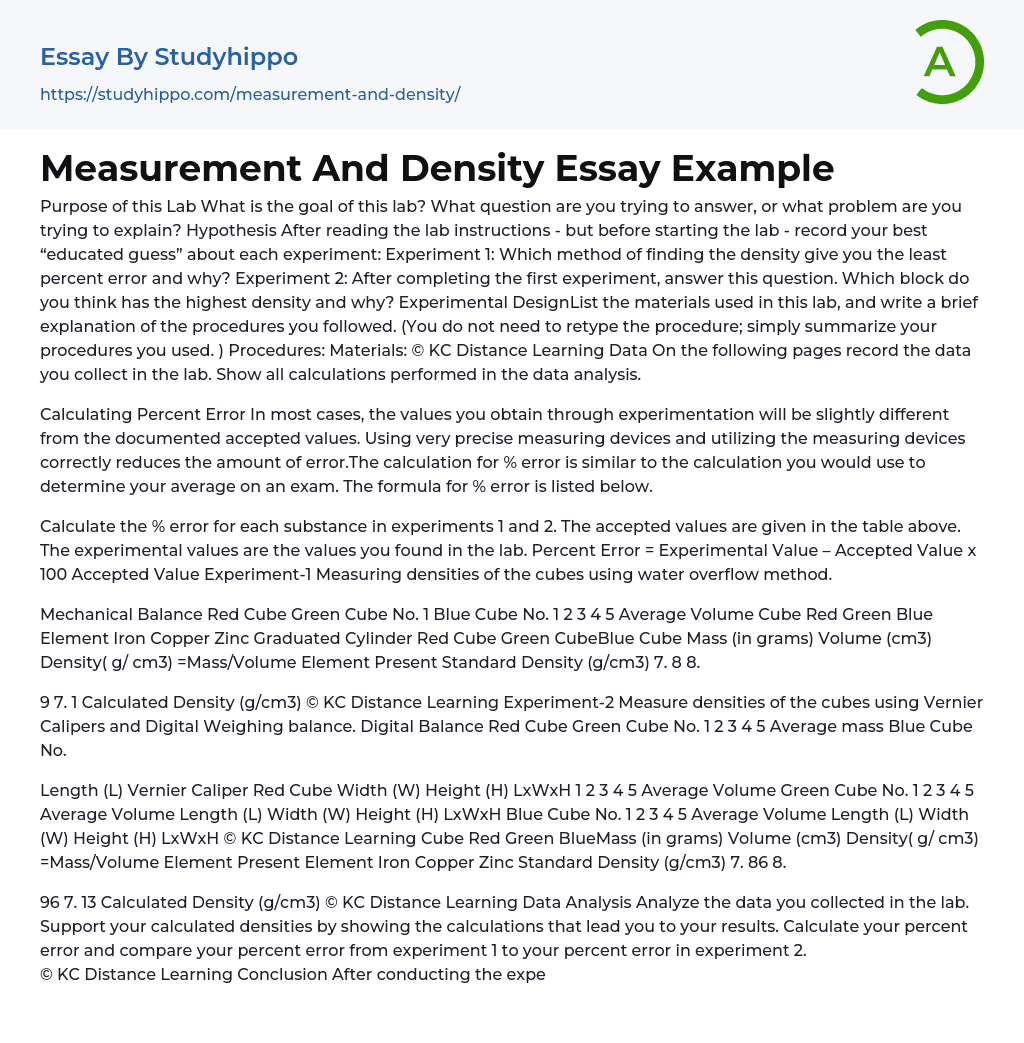The laboratory's goal is to resolve an issue or ascertain an answer to a question. It is suggested to formulate the hypothesis before starting with the tests. This will necessitate making educated assumptions about Experiment 1, which examines the approach that generates the least percentage error in density determination and its reasoning; as well as Experiment 2, which investigates which block has the highest density and why. The experimental design involves a list of materials employed in the laboratory and a brief description of procedures. Information is obtained during experimentation, and all calculations carried out during data analysis need to be recorded on subsequent pages.;;;KC;Distance;Learning
When conducting experiments, it is common to obtain values that differ slightly from the documented accepted values. To reduce error, it is important to use accurate measuring devices and use them correctly. Th
...e calculation for determining percent error is comparable to calculating an exam average. The formula for percent error is provided below.
Calculate the percentage error of each substance in experiments 1 and 2, using the values provided in the above table. Determine your experimental values in the laboratory, then plug them into the percent error formula: (Experimental Value – Accepted Value) x 100 / Accepted Value. Experiment-1 involved measuring the densities of cubes via water overflow method.
The table presented below exhibits the results of a mechanical balance experiment using numbered red, green, and blue cubes. The data includes measurements of mass, volume, and calculated density for each cube. Notably, the cubes are made up of different elements such as iron, copper, and zinc. The experiment involved using a graduated cylinder to measure liquid volumes. Finally, the table compares each element's
standard density with its calculated density.
< td >5
< td >
< td >
< td >
< td >Copper
| <tsd> | Blue >0.8 cm3</tsd> | <dhfjhdgfkjlhnklb;jkloirug yqerwyigfbvcmncxuiaoiwqegfygfdhjnklsfgvjdfghjkloiuytrewqaqwertyuioplkjhgfdszxcvbnmnbvcxzasdfghjklpoiuytrewqazxcvb> |
The density of calculated (in g/cm3) for Experiment-2 can be measured for various colored cubes using Vernier Calipers and Digital Weighing balance. The weights for each cube (Red,
Green, and Blue) can be measured using the balance. The results are recorded in a table with columns for the cube number (1-5) and the average mass. © KC Distance Learning.
The Vernier Caliper was used to measure the length (L), width (W), and height (H) of Red, Green, and Blue cubes. The average volumes of the Red and Green cubes were calculated, along with their masses and densities (mass/volume). The presence of Iron, Copper, and Zinc in each cube was identified. It should be noted that standard density values for these elements are: Iron - 7.86 g/cm3, Copper - 8.96 g/cm3, Zinc - 7.13 g/cm3.
96 7. 13 Calculated Density (g/cm3) © KC Distance Learning
The lab data needs to be analyzed, including the calculations used to determine the calculated densities. Additionally, the percent error should be calculated and experiment 1 and experiment 2 results should be compared. Once the experiment is complete, a conclusion must be provided which explains any problems or answers raised by the lab's purpose. It is important to determine if the hypothesis is supported by gathered data and use it as evidence for your answer. Finally, evaluate if there are other explanations that could explain your conclusion.
Answer the post lab questions provided by KC Distance Learning before submitting your report to your teacher. Make sure to present all calculations wherever required. For reference purposes, use the following table that displays the density of different substances, including Aluminum, Oak, Pine, Polypropylene, PVC, Steel, Water, Lead and Bismuth, in grams per cubic centimeter (g/cm3):
Density Table
Substance
Aluminum
Oak
Pine
Polypropylene
PVC
Steel
Water
Lead
Bismuth
Density (g/cm3)
2.70
0.
75 0.42
0.2 1.40 7.9 1.0 11.
Should the density of a damaged metal object shaped like a cube be determined by measuring only one side and cubing it, without any further data? Explain your reasoning.
2. If the density of a cube is determined to be 1.40 g/cm3, would it differ if another cube made of the same material has twice its mass? Explain.
3. A cube with a mass of 0.
Identify the object with a volume of 20.0 cm3 and weighing 0084 kilograms, using the density table provided. Make sure to convert, if necessary. 4.
Based on the density of lead in the table provided, what is the mass of a lead cube with 7.00 centimeter sides? © KC Distance Learning 5.
When you add a piece of aluminum weighing 15.00 grams to a graduated cylinder filled with 50.00 milliliters of water, the water level will increase.
After dropping the aluminum, what would be the new volume of the graduated cylinder? Also, how many substances from the density table provided would float in water?
© KC Distance Learning
- Atom essays
- Big Bang Theory essays
- Density essays
- Electricity essays
- Energy essays
- Force essays
- Heat essays
- Light essays
- Motion essays
- Nuclear Power essays
- Physiology essays
- Sound essays
- Speed essays
- Temperature essays
- Thermodynamics essays
- Experiment essays
- Explorer essays
- Hypothesis essays
- Observation essays
- Qualitative Research essays
- Research Methods essays
- Theory essays
- John Locke essays
- 9/11 essays
- A Good Teacher essays
- A Healthy Diet essays
- A Modest Proposal essays
- A&P essays
- Academic Achievement essays
- Achievement essays
- Achieving goals essays
- Admission essays
- Advantages And Disadvantages Of Internet essays
- Alcoholic drinks essays
- Ammonia essays
- Analytical essays
- Ancient Olympic Games essays
- APA essays
- Arabian Peninsula essays
- Argument essays
- Argumentative essays
- Art essays
- Atlantic Ocean essays
- Auto-ethnography essays
- Autobiography essays
- Ballad essays
- Batman essays
- Binge Eating essays
- Black Power Movement essays
- Blogger essays


Unfortunately copying the content is not possible
Tell us your email address and we’ll send this sample there.
By continuing, you agree to our Terms and Conditions.


